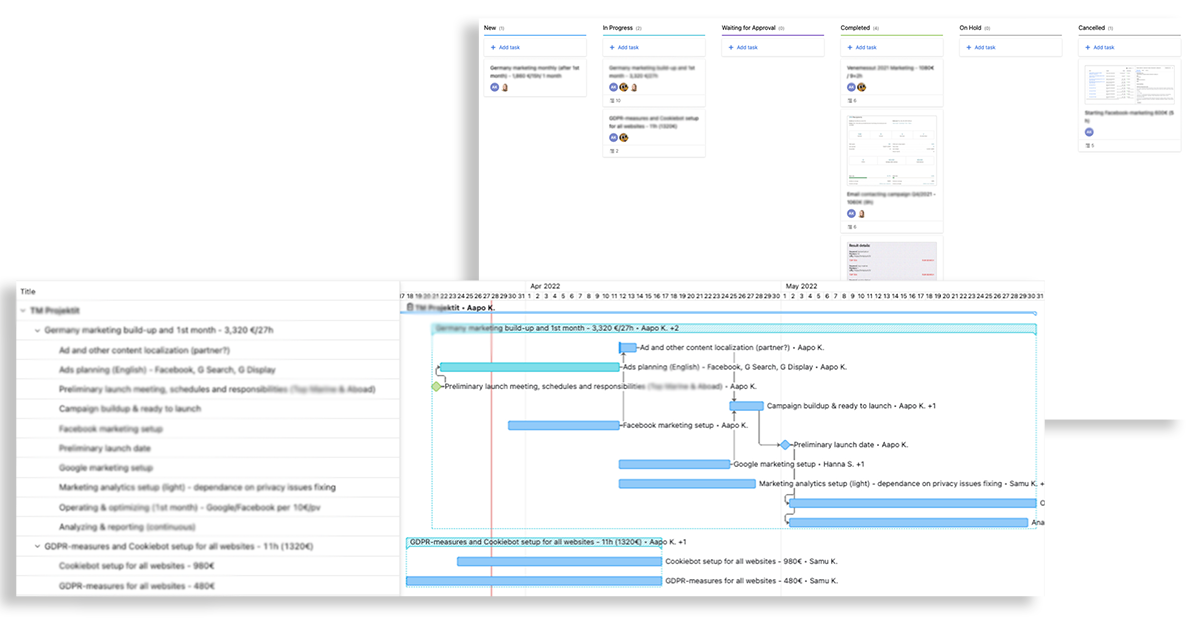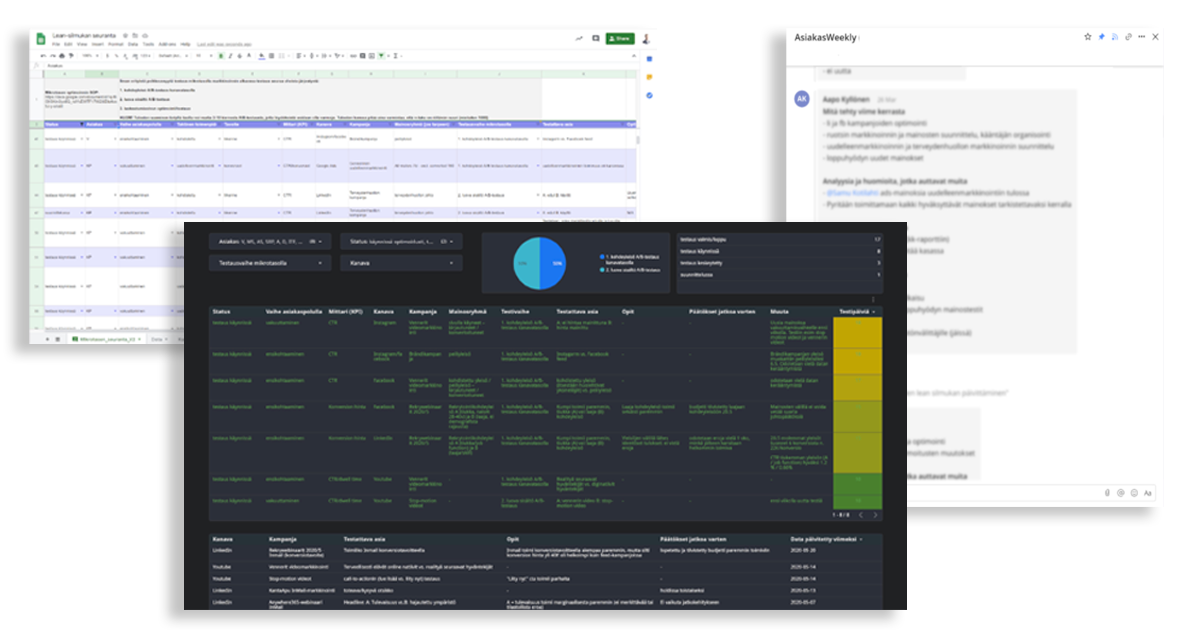Project management is not the most exciting topic in marketing, but it is an essential one. Based on my experience, companies often face challenges such as a lack of planning, unstructured execution, and ideas that remain isolated experiments or never get practically implemented. In my opinion, all of these are byproducts of either high-quality project management or its absence. So, what kind of project management is needed in marketing?
Communication and organizational structure
Communication needs are heavily dependent on the organization’s structure. Communication between small in-house teams, fully outsourced marketing machinery, or departments in large corporations all pose their own challenges to communication. In this text, I address communication from the perspective of a hybrid team, a combination of internal and external marketing resources, for two reasons: I believe that the challenges faced by such organizations are the most common, and at the same time, I encourage organizations to adopt a hybrid mindset rather than an either-or approach (internal vs. outsourced). Additionally, from a communication standpoint, it is irrelevant whether this type of organization operates remotely or in-office.
Technology
While every aspect of communication can be approached from a technological perspective, selecting communication technology is crucial. In essence, it doesn’t matter what technologies a company chooses for its communication as long as they are appropriate and functional. I recommend considering commonly used platforms (Google’s environment, Slack, Teams) because they facilitate easier integration with external partners and require less training.
Culture
When it comes to communication culture within an organization, it is essential to have an open yet structured communication approach. Responsibilities must be clear, as well as which channels are used for what purposes. For example, I can refer to our organization’s communication, where customer- and project-specific matters are always communicated through the project management system under the respective task, ensuring that everything is documented and revisited as needed. In addition to this, each client has its own Slack channel, intended for more immediate, reactive, and ideation-focused communication. It’s essential to undoubtedly document the basic rules of communication so that they can be easily communicated to new employees and partners.
Scheduling, budgeting, and prioritization
If things are not scheduled or budgeted, they won’t happen. Although the nature of work may determine its own limits for planning and budgeting various activities, I believe even the smallest tasks should be scheduled and prioritized. In a healthy organization, prioritization is inevitable, driving efficiency and ideally leading to a situation where less productive tasks make way for higher-priority ones. If things are not prioritized, most of the time can be spent on meaningless tasks, consuming a lot of resources but producing minimal results.
Staying within budget
Whether working in-house or at a marketing agency, my advice is to stick to the schedule and budget whenever possible. If external factors change the situation, communicate them immediately and explain how and why they affect the schedule or budget, providing a new proposal transparently and promptly. Marketing expectations are often unrealistic, and deviating from schedules or budgets reduces the credibility even more, no matter if the results are good. Therefore, it is essential to adhere to agreed-upon frames for each task.
Tools and practises
Budgeting and scheduling are skills learned through experience and are worth investing in. There are also good tools and templates available from which each organization can find its own. For example, in our lean marketing process, we use the Kanban model for project flow and Gantt charts for task scheduling.

Structured testing and documentation of learnings
A learning and efficient marketing process not only produces results but also generates valuable lessons for business development. Learnings can be used to optimize further and enhance marketing, create insights to increase customer understanding or identify bottlenecks in the customer lifecycle process. This creates a positive cycle of learning, which we call the lean loop. However, it doesn’t happen by itself or by chance.
Lean framework for systematic testing
Testing should already start in the planning phase so that the activities can reliably rely on its results. Therefore, the structure of project management plays a vital role in testing because, ideally, it creates a culture of experimentation and testing where each action yields insights and progresses forward. Our way of maintaining the testing structure is by a lean framework for all activities. As I’m writing this, our micro-level documentation table for the lean loop has recorded over 800 rows of campaigns, activities, and test targets. This documentation model has two superior advantages:
- It forces us to define and track each activity’s testing objective, ensuring that all actions are planned, involve active testing, and stay constantly updated. Passive, self-running campaigns are not part of the lean marketing mindset.
- All test targets, activities, and results must be documented in the same place, serving as a testing backlog. The results are reviewed in our weekly meetings and are automatically stored in the system whenever a new test target is created. This allows us to revisit results and activities retrospectively.
Test objectives must be planned in advance
Never rely on test results that occur by chance—because that’s likely what they are. If test targets are not carefully planned, conclusions cannot be drawn afterward by simply looking at the results. Even carefully planned tests always require multiple test rounds to eliminate the possibility of chance and achieve sufficient statistical significance. Properly built project management is the solution for this because it forces us to define a testing objective for each activity and critically examine its results.
Learn more about our Lean marketing principles >
Scaling and efficiency of activities
For each task, determine how much resources it requires, its expected return on investment, and in what timeframe it is realistic to implement. By listing all ideas and upcoming tasks in this way, it quickly becomes clear where to focus and which things to leave for last or completely on the brainstorming table. However, this should not be the end; after completing the work, it is necessary to revisit the hypothesis and evaluate whether the given schedule and budget were adhered to (if not, why), whether the expected results were achieved, and what could be learned from them. This helps identify potential errors and efficiently scale successful actions forward.
Documentation of mistakes
If errors are noticed in processes, they often recur in all activities. For efficiency’s sake, documenting errors is important to make them visible. If every person repeats the same mistake in the same task every time, it can become a significant productivity barrier in the long run—especially if it goes unnoticed. Documenting one person’s mistake can help the entire organization avoid the same mistake, ultimately leading to a culture of organizational learning.
Learning organization
The same applies in a positive direction. If good results are achieved in a certain activity, it is worth considering what factors led to them and how they could be replicated in other activities. For example, we utilize this approach by scaling successful actions to other clients if we achieve particularly good results for one client with a particular activity. This way, we can create more value for each client by scaling learning and activities across industries, accelerating faster, and generating more insight than a single organization would ever do. Scalability is one of the cornerstones of lean thinking.

Communicating learnings and actions within the organization
Communication between sales and marketing
What good is it to accumulate lessons if their results are not communicated within the organization? Even though a structured testing culture has been brought into daily work through project management, it is only significantly beneficial if the results reach all critical stakeholders within the organization. Such information gaps are often observed, for example, between sales and marketing. If information does not flow, even high-quality marketing and sales professionals will not achieve their full potential. Our solution to this is joint weekly meetings between sales and marketing, where the most important things from the commercial development field are discussed in a tight 15-30 minutes:
- What has been done,
- What results and lessons have been achieved in relation to the objectives and
- What will be done next based on these?
We have concretely seen how the efficiency of commercial development has taken leaps forward when sales and marketing sit at the same table weekly. This way, both organizations gain an understanding of common actions and their effects on their work. Quickly, we also reach a situation where natural co-development and brainstorming begin to roll and accelerate the pace even further.
Reporting upwards
Communicating upwards is also important, and structured testing supported by reliable documentation assists in this goal excellently. At the weekly level, practical actions and grassroots-level lessons can be illustrated for the company’s management, explaining what they have achieved. However, for more prominent themes, it is advisable to seek a sufficient sample and ensure the reliability of the results before reporting them further. When this is the case, it is worthwhile to include in the report not only the presented data and observations but also an analysis of what the result practically means, as well as a proposal for action, what its practical effects are, and what should be recommended to do next based on it.
Internal skills and knowledge sharing
One tool we use for internal communication, knowledge transfer, and scalability is the SOP template (Standard Operating Procedure). Its purpose is for the expert, holder, or person responsible for each process to describe the process step by step. SOPs can be used in both the company’s project management tasks and in more tactical tasks, such as defining the use of a specific marketing channel. It allows knowledge to be transferred within the organization so that if, for example, a certain person falls ill, others can easily handle their responsibilities using the SOP instructions. On the other hand, onboarding new personnel or partners to processes is easily achieved.
Learn more on how to disseminate the latest marketing information to the team >
Begin with small steps
Tools alone do not bring happiness, let alone technologies. The lean thinking mindset, the processes, and the practices it brings require time—and ultimately, the same methods may not work for everyone. However, if you notice significant areas for improvement in your organization in the areas above, it’s worth starting the development process by mapping the current state. After that, it’s time to create the first internal processes and practices and choose the right tools to support them.
Only take on 1–2 new practices or tools at a time, as otherwise, they are doomed to fail. Just as repetitions are needed for daily tasks to become ingrained, the same amount of time should be given to refining processes and evaluating their suitability for your organization.
So, put on your lean glasses and embark on the journey towards more efficient project management and a more structured and learning-oriented marketing process! You can start by exploring our extensive resource bank, which provides more information on lean marketing and its key tools. However, if you suspect that you need help in the early stages of your journey or a long-term partner to support your development, book a quick 15-minute conversation, and let’s see if we can help!
Also read:
B2B marketing tools 2024 – In this way, we use them collectively >
